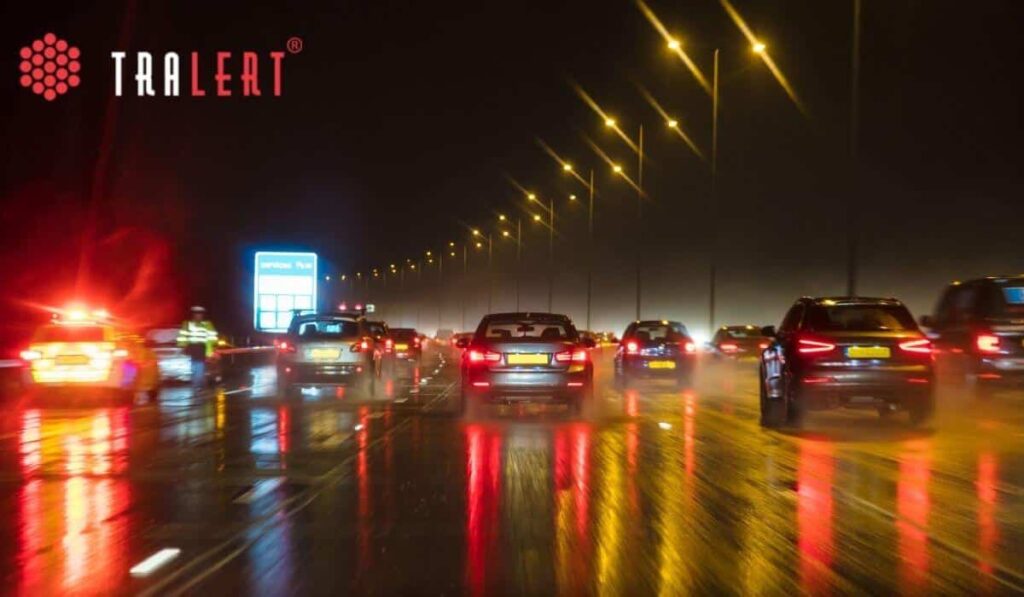In traffic, you can find yourself in many different situations. The type of lighting you need may depend on where you are driving, such as in built-up areas, on a motorway or driving through a tunnel. But the weather can also affect the lighting you need to have on. A car has special fog lights, but when can they actually be used? The time of day also has an influence: which lights can you use during the day and which ones in the evening. When are you allowed to have high beams and when low beams? Different lights apply in different situations. That is why we put everything side by side.

Different types of lighting
Before we look at different situations, it's useful to first examine the most common types of vehicle lighting. A vehicle has various types of lighting, each with its own purpose. Not every type of lighting can be used in every situation. Therefore, it's important to know which lights should be used with your car in a specific situation. For example, fog lights are intended for use when there is fog. However, the fog must be thick enough before you can use fog lights. More information on this will follow regarding weather conditions.
When dipped headlights?
Dipped-beam headlamps are also seen as the normal light of a vehicle. It is meant to be seen well, but also to be seen better yourself. In the evenings, it is compulsory to have dipped headlights. You can imagine what would happen if someone were to drive in traffic without lights in the evening. Besides the evenings, you may also use the lights during the day. In bad weather, such as rain, you may also use dipped headlights. The reason for this is to be more visible but also to be able to see yourself better.
Daytime running lights
Daytime running lights are the answer to the question of which lights you may use with your car during the day. As the name suggests, these lights are intended for daytime use. They help you be more visible during daylight hours. Unlike many other lights in traffic, daytime running lights are not mandatory. Newer cars often come equipped with them as standard, but older cars may not have them. If you want more information about daytime running lights, I refer you to a previous blog on daytime running light requirements. The blog delves deeper into this type of lighting. Additionally, daytime running lights ensure that if there is a failure in your headlights, they still indicate the width of your vehicle.
When are you allowed to have high beams?
Another type of lighting that is widely used is the large light. These lights may only be used in the evenings. The lights are so bright that they can blind other road users. It may therefore not be used in every situation. When you are driving behind another vehicle, you are not allowed to use the high beam. It is also forbidden to drive with a high beam when there is another vehicle approaching. You may therefore only use a high beam when you cannot blind other road users with it. This can be especially useful when driving in the forest or on poorly lit roads.
Rear lights
The answer to the question of when you may use rear lights is quite simple. Rear lights must always be on when high beams, low beams, or fog lights are in use. It can never be the case that only the rear lights are on. They must always be used in combination with one of those forms of lighting.
Time of day
As already briefly mentioned, the time of day has a great influence on which light or lights must or may be used in the car. This is partly dependent on the weather conditions. These will be discussed in detail later on.
Which light or which lights are obligatory for car during the day?
During the day, it is not compulsory to have certain lighting. However, it is possible to have daytime running lights but, as mentioned earlier, not every car is equipped with them. In weather conditions where visibility is less than normal, it is wise to switch on the lights of your vehicle. These are the dipped headlights and the rear lights.
In the evening
In the evenings, in addition to a recommendation, it is simply compulsory to have your lights on on the road. Daytime running lights are not sufficient. When it is evening, you must have both low beam and tail lights on the public roads. Both lights ensure that you are more visible to other road users. The dipped headlights also ensure that you can see the road better yourself. If you want to have more visibility, you can also have a high beam. But this is not always allowed. You may only use a high beam when there are no other road users around who could blind you. This means the traffic behind you and the traffic coming towards you.
Weather conditions
The rules concerning lighting also change in different weather conditions. The best example of this is the fog lights. These are, of course, meant for when it is foggy. But it is also important how dense the fog is. You are not allowed to use them even in the smallest amount of fog. Which lights you should have on your car therefore also depends on how heavy the weather is.
Rain, hail or snow
Different weather conditions can affect visibility in traffic. First of all, there is rain, hail and snow. These conditions have a negative effect on visibility in traffic. It is not compulsory to have certain lights in these conditions. However, as a driver, you are expected to drive with both your dipped headlight and your rear light on when the weather is bad. If you think that daytime running lights are good enough because your car is equipped with them, you are wrong.
Daytime running lights are not visible enough in bad weather. In addition, some cars only have daytime running lights at the front of the vehicle. In those cases, you are still not visible from the rear. You are only allowed to use fog lights when the weather makes it almost impossible for you to see anything, more on this later. So make sure you just turn on your dipped headlights when the weather is bad.
When to have fog lights, and when not to have them?
Fog has a huge impact on visibility in traffic. That is why every vehicle is equipped with special fog lights. You would say that it is simple: when you can see less because of fog, you switch them on, but it is not that simple. The fog has to be sufficiently dense for cars to be able to use fog lights. Fog lights may only be used in really dense fog, otherwise they can be annoying for other road users. The lights have a wide beam and actually try to shine through the fog to make the road surface more visible.
If you want to know when you are allowed to have which lights on your car, two distances are important to keep in mind. These are 200 and 50 metres. When you cannot see more than 200 metres ahead because of the weather, you may use your fog lights. When you cannot see more than 50 metres ahead, you can also use your rear fog lights. An easy way to keep track of this is by looking at the hectometer posts along the road. There is 100 metres between each post. When you drive past a post and you can only see the next one, visibility is less than 200 metres. If you cannot see the first pole, visibility is in any case less than 100 metres.
No high beam in fog
What is useful to bear in mind is that having more light does not always provide better visibility. In the case of fog, it is very unwise to drive with high beams. You would think that you would be able to see more with a high beam, but this is not the case in fog. When you run your headlights in dense fog, you see a lot less than normal. This is because the light is reflected in the fog and you blind yourself, as it were.

Locations
In addition to the different weather conditions, the place where you drive is also important when it comes to the lighting of your vehicle. In different places, different lighting is expected of you. The best example of this is when driving through a tunnel, which lighting do you need?
Inside and outside the built-up area
It is sometimes unclear whether you are allowed to have high beam lights on in built-up areas. The site of the national government states that this is simply permitted. Of course, the usual rules apply to the use of high beams in the presence of other road users. You must therefore pay attention to this. There is also a greater chance in built-up areas that there will be people walking along the road. These too may experience inconvenience when you drive with high beam lights. Due to the normally abundant street lighting, the use of high beams is not actually necessary.
What lighting in tunnel?
You have probably come across a sign before entering a tunnel that says 'switch on your lights', but which car light is it referring to? In tunnels you are always asked to have the correct lights on. This is because it can be very dark in a tunnel. The transition from light to dark does not make it any clearer. That is why the sign is often there. It is important that when you approach a tunnel you switch on your dipped headlights manually. Daytime running lights are not enough to be clearly visible in tunnels either. Especially since not every car is equipped with daytime running lights at the rear of the vehicle. If you do not switch your dipped headlights on manually, you may have no light at the back.
Even in cars where the lights are switched on automatically, it is advisable to do this manually when driving through tunnels. It is possible that the system does not immediately see that you are driving in a dark tunnel. The safe and sensible option is therefore to do this yourself. When you drive out of the tunnel, you can simply switch the lights back on automatically.

What if I am not driving with the right lights?
Now I hear you thinking, what if I drive with the wrong lights in a certain situation. Which light you use with your car is very important, which is why there are fines for the improper use of lights. When you drive with broken lights or lights that do not work properly, you risk a fine that can amount up to 150 euros. When it comes to the license plate lighting, you may get away with a fine of 50 euros. We have already discussed the use of fog lights. The rules with visibility less than 200 metres and 50 metres. These are very important to observe. If you use fog lights incorrectly, you can be fined up to 150 euros. Simply because you can blind other road users with them.
In practice, you often see road users shining their headlights at each other. This can be to make it clear to people that the lights are not on, that you want to give them the right of way or that a speed check is coming up. It is always well-intentioned, but it is still forbidden. A fine of €100 is imposed for wrongfully signalling.

